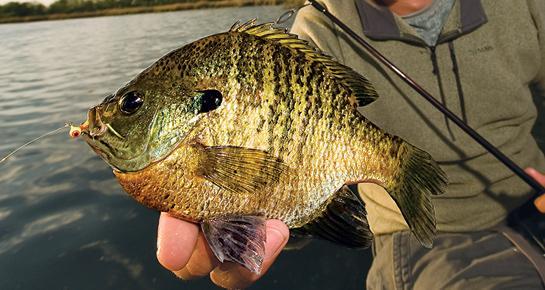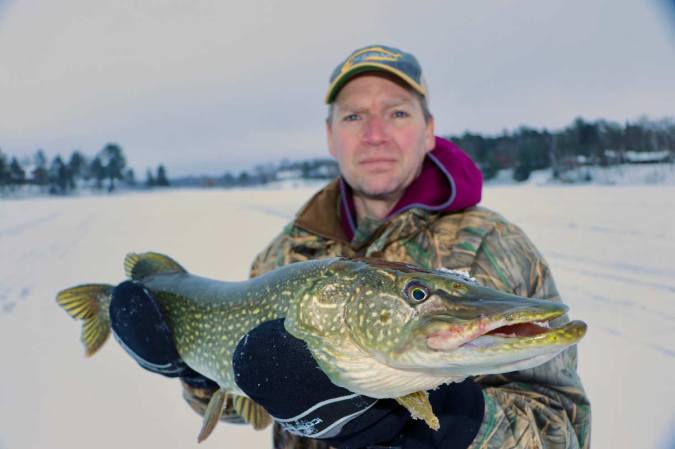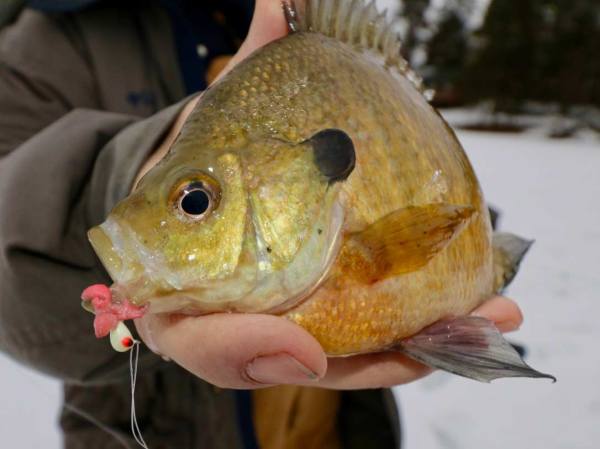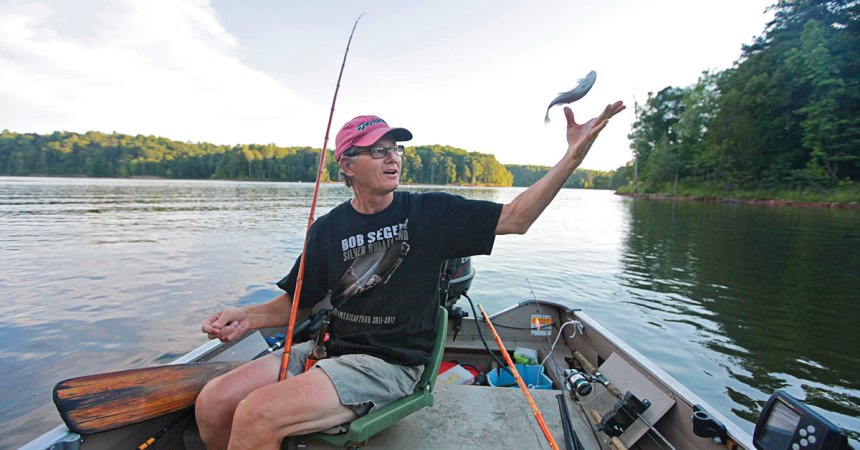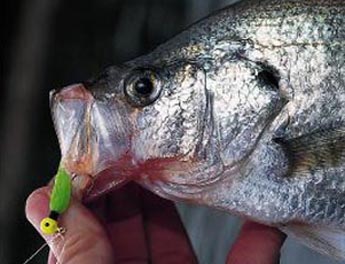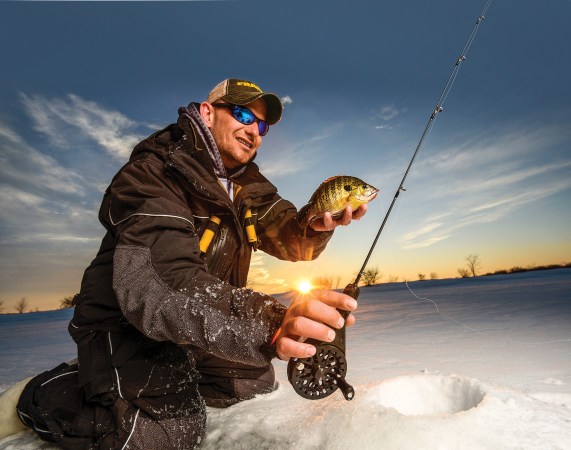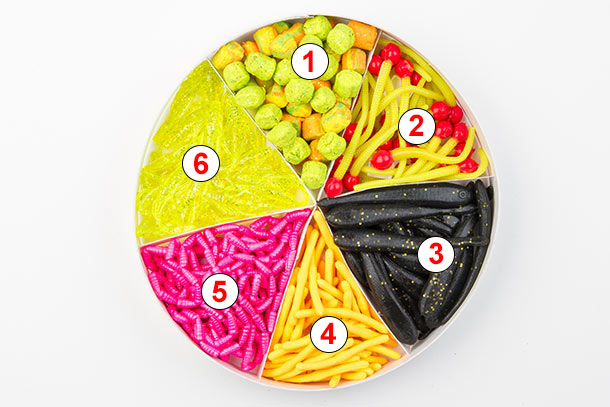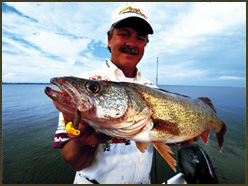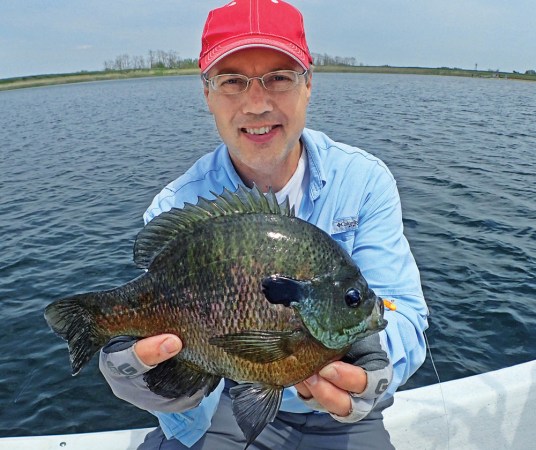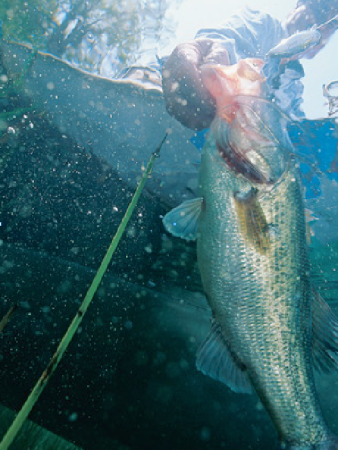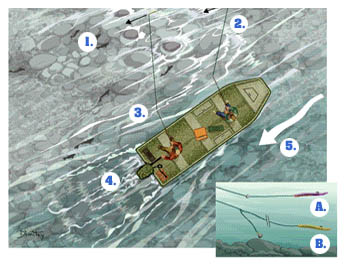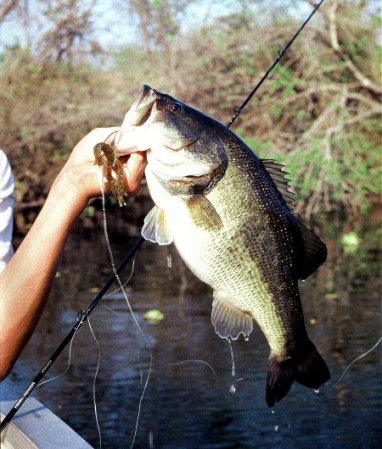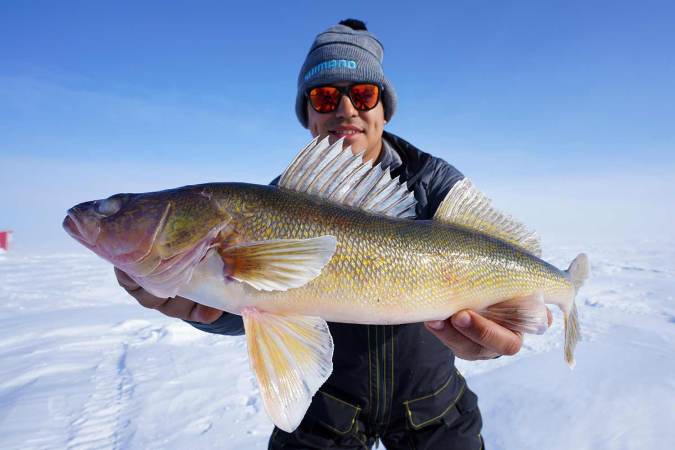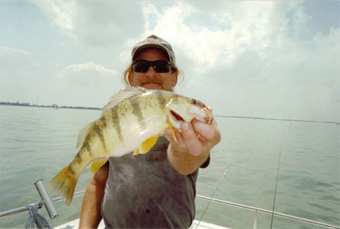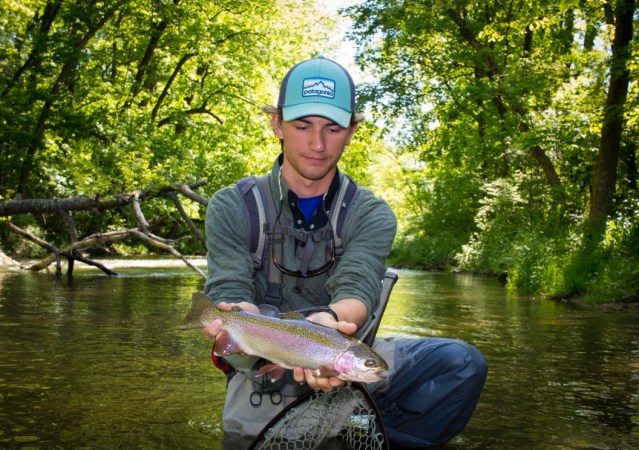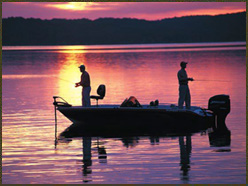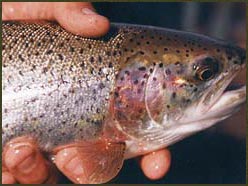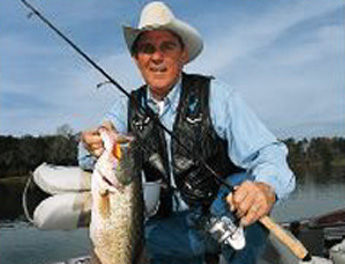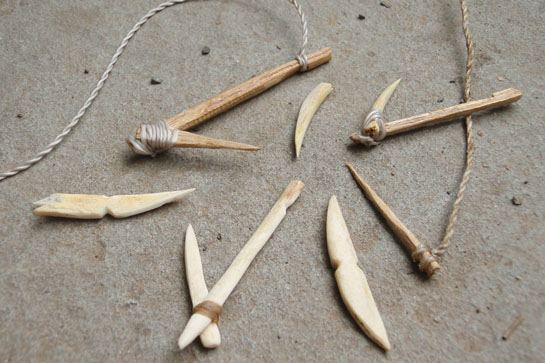Here’s everythingyou need to know to get youngsters hooked on their first cast
SOME ANGLERS SAYTHE HARD-FIGHTING SMALLMOUTH BASS is the finest sport fish swimming. Othersfavor the acrobatic trout or the heavyweight striped bass. When all the votesare in, however, panfish are America’s favorite catch. As national surveys haveindicated time and again, no group of fish gives more pleasure to more peoplethan this assortment of scrappy little firecrackers.
The panfish clubembraces a mix of finny characters, each of which will fit quite nicely in apan, as the name suggests. They include bluegills, redear sunfish, crappies,yellow perch, white bass, warmouths and bullheads. All are great fun to catchon light tackle, and most people fish for them with natural baits such asearthworms, crickets or live minnows. Panfish swim in lakes, ponds and streamsthroughout most of the country. They put up a fight out of all proportion totheir size and rank among the best-tasting fish on earth–reasons enough toenjoy fishing for them.
Remember when youthought catching panfish was the greatest thing going? Maybe it’s time torecapture that feeling. And be sure to take along a youngster.
RIGGED UP ANDREADY TO FISH
For most of us, acane pole and a can of worms are part of our first memories of fishing. One ofthe great things about panfish is that they don’t care how fancy your tackleis, as long as it puts the right bait in front of them. Use a cane orfiberglass pole if you want to keep it simple, or opt for a light-weightspinning or spin-cast outfit to reach places farther offshore.
Choosing arod-and-reel combo for panfish is like buying a truck. Hundreds of styles areavailable– everything from simple, inexpensive models to top-of-the-line,feature-heavy imports. Anglers need and want different things.
Before you buy,consider these components of a good panfishing outfit.
THE RIGHT ROD:You should know what you’ll be fishing before choosing your rod’s power rating(ultralight, light, medium, etc.). If you’re going to use artificial luresinstead of bait, ultralight rods are great for 1- to 4-pound-test lines andlures weighing 1/64 to 1/16 ounce. Light rods are best for 4- to 8-pound-testlines and 1/32- to 1/8-ounce lures. Most panfish anglers favor rods with thesepower ratings, although medium-weight rods (for lines of 4- to 12-pound-testand 1/8- to 3/8-ounce lures) sometimes are used as well.
The length shoulddepend on the application you have in mind. If you need to make long casts inclear water to avoid spooking fish, a longer rod is the top choice. For generalpanfishing, a 4½- to 6-foot ultralight or light model will do.
REEL CONCERNS:Reels are available in three basic types: bait-casting, spinning and spin-cast.Most bait-casting reels are unsuitable for fishing the light lines, small luresand tiny baits designed for bluegills and the like.
Spinning reels,sometimes called open-face reels, are ideal because they handlesmaller-diameter lines well. However, spin-cast reels, also known as pushbuttonreels, are still the traditional favorites of many panfish fans. Spin-castreels offer simple pushbutton casting control. Because they’re simpler to useand rarely cause line snarls, they’re perfect for children and novice adultslearning to cast.
The type of reelyou choose also will determine the type of rod you need. If you prefer aspinning reel, it must be matched with a spinning or flyfishing rod. Likewise,spin-cast reels are usually mounted on bait-casting rods. The exceptions arethe spin-cast reels (so-called “underspin” reels) that release line viaa finger lever and are designed to be paired with spinning or flyfishingrods.
SELECTING THEPERFECT HOOK
The mostimportant, but frequently overlooked, facet of panfishing is choosing a hook ofthe right size and style for the job at hand. Bluegills have relatively tinymouths because they primarily eat tiny crustaceans and insects. Crappies, onthe other hand, have large mouths–the better to vacuum in live minnows. Ifyou’re fishing for bluegills and getting bites but missing the fish, chancesare the hook is too big for the fish’s mouth. A small hook might catch a bigfish, but the reverse is seldom true.
When choosingfrom the scores of hook designs, panfish anglers should consider three hookcharacteristics: size, thickness and shank length.
A hook’s size isindicated by a number that reflects the gap of the hook–the distance betweenthe point and inside of the shank. Smaller hooks, from No. 14 (or even smaller)up to No. 1, decrease in size as the number increases. For example, a No. 14hook is extremely small and used only for the smallest baits, like mealworms. ANo. 8 hook (the best-selling size) is quite a bit larger but still suitable forfish such as bluegills and perch, which have slightly larger mouths. No. 1hooks are larger still and are a good size for bullheads, crappies, white bassand other large-mouthed panfish.
As you move toeven larger hook sizes, the numbering system changes to “aught”designations and reverses direction. The next larger size after No. 1 is 1/0,and hooks increase in size as the numbers increase–2/0,3/0,4/0 and so on. The2/0 size is the largest hook commonly used by panfish anglers. Such biggerhooks–from No. 4s up–are okay for crappies, white bass and warmouths.
Hooks also varyin thickness, according to the type of wire from which they are manufactured.Light-wire hooks, such as the extremely popular Aberdeen or Carlisle styles,work best in most panfishing situations. They do the least damage to small,fragile baits such as insects and worms, and they usually will bend enough topull free of wood cover, reed stems or lily pad stalks. Once they’re extractedyou can reshape the hooks to their original configuration.
Most hook stylesalso are available with shanks of varying lengths. Panfish anglers usuallyprefer hooks with long shanks because they’re easier to remove fromsmall-mouthed fish.
Various otherhook innovations also should be considered. Weedless hooks help preventhang-ups in dense cover. Treble hooks, especially spring-wound models, keepdoughbaits and other soft bullhead baits from slipping off. Small bait-holderhooks, which have barbed shanks, are popular with anglers who use baits such aworms or mealworms that tend to slide off the shank. Tiny circle hooks willimpale most panfish in the corner of the mouth instead of deep in the throat,permitting live release.
Don’t burdenyourself trying to learn all the different styles of hooks. Find a few thatwork for you and stick with them.
CATCH YOUR OWNMINNOWS
If you’re goingafter bigger game, such as crappies or white bass, worms won’t do. Live, friskyminnows are the best bet and are readily attainable from bait shops. If you’readventurous, try your hand at catching your own. Seining or trapping wildminnows for bait has long been a part of panfishing tradition.
Seines, which arenothing more than long nets made of soft synthetic mesh, can be purchased fromfishing tackle supply outlets. Once you’ve reached the ditch or creek where youplan to net your bait, it’s just a matter of tying a couple of old mop handlesor thick sticks to either end of the seine and wading into the water. You and apartner on the other end of the seine then walk forward, checking the seine nowand then and depositing any suitable minnows you catch in a bait bucket.
Nowadays mostminnow traps are cages with funneled entrances made of coated or galvanizedwire. Plastic models, which tend to be lower-priced yet less durable, also areavailable. Either way, stale bread is usually the only encouragement minnowsneed to make the one-way trip up the trap’s funnel to their prison chamber.
Catch ‘Em With These Combos
1. Top of the Line Shakespeare Dimension Spinning Combo Rod: Lightweight 5-foot, IM-7 graphite rod with cork handles, stainless-steelguides and a graphite reel seat with stainless-steel hoods. Reel: ShakespeareDimension 25 spinning reel has nine ball bearings, instant anti-reverse and agraphite body. Line capacity: 115 yards/4-pound-test. Gear ratio: 5.2:1. Cost:$50. Contact: Shakespeare; 803-754-7000; shakespeare-fishing.com.
2. A Mighty Mite for Ultralight Lures Pflueger Trion GX 48 Micro Ultralight Combo Rod: 4-foot 8-inch, one-piece ultralight spinning rod with IM-6 graphiteconstruction and a top-grade cork handle. Reel: Trion 4720GX ultralightspinning reel features two ball bearings, instant anti-reverse and a machinedhandle with a rosewood knob. Line capacity: 105 yards/4-pound-test. Gear ratio:5.2:1. Cost: $40. Contact: Pflueger Fishing Tackle; 800-347-3759;pfluegerfishing.com.
3. Great for Youngsters Zebco SlabSeeker Micro Spin-cast Combo Rod: 6-foot, two-piece SlabSeeker rod with ultra-sensitive Tap Action Tip.Reel: Micro spin-cast reel with dial-adjustable drag is easy for kids to use,so break them in with this outfit. Line capacity: 75 yards/4-pound-test. Gearratio: 4.3:1. Cost: $25. Contact: Zebco; 918-836-5581; zebco.com.
4. Best Crappie Outfit Cabela’s Fish Eagle UL/Crappie Systems Rod: Crappie System Spinning Rods (9- or 12-foot models) have a sensitive tipfor better bite detection in deep water. Reel: Fish Eagle UL spinning reelfeatures instant anti-reverse, three-bearing drive, a graphite frame and rotorand smooth disc drag. Line capacity: 120 yards/4-pound-test. Gear ratio: 5.2:1.Cost: About $65. Contact: Cabela’s; 800-237-4444; cabelas.com.
Eat ‘Em Up Recipes
Perch Cakes
1 lb. fillets, cooked, flaked
1 egg, beaten
1 onion, minced
1 tb. lemon juice
1 tsp. parsley flakes
¼ tsp. pepper
¼ to ½ cup cornflake crumbs
2 tb. mustard
½ tsp. salt Vegetable oil
Directions: Mix egg, onion, mustard, lemon juice,parsley, salt and pepper in a bowl; toss with flaked fish. Add enough cornflakecrumbs to shape 4 to 6 fish cakes. Roll each cake in extra crumbs to coat theoutside. Heat the oil in a skillet, and fry cakes until crisp and brown.
Hooking Up
1. Mustad 92641 Baitholder Hooks, sizes 6 to 2/0 Best for: Tiny barbs hold earthworms, leeches or prepared baits in place.Contact: O. Mustad & Son, 315-253-2793, mustad.no.
2. Mustad 3261D Cricket Hooks, sizes 12 to 6 Best for: Crickets, earthworms. Long shank facilitates hook removal fromsmall-mouthed sunfish.
3. Eagle Claw 202 Aberdeen, sizes 12 to 2/0 Best for: Hooking live minnows through the back for crappies and white bass.Contact: Eagle Claw Fishing Tackle, 720-941-8700, eagleclaw.com.
4. Tru-Turn 868 XLong Blood Red Panfish Hooks, sizes10 to 2 Best for: Crickets and earthworms for various sunfish. Contact: Tru-Turn Hooks,334-567-2011, truturnhooks.com.
5. Mr. Crappie 35B Cam-Action Red Hooks, sizes 8 to1 Best for: Offset shank aids hook-setting. Contact: Mr. Crappie,mrcrappie.com.
6. Gamakatsu 51408 Shiner Hooks, sizes 6 to 2/0 Best for: Lip-hooking shiners when slow-trolling for crappies and white bass.Contact: Gamakatsu, 253-922-8373, gamakatsu.com.
Build a Backyard Worm Bed
The ultimate live bait for everything from yellowperch to bullheads is a big, fat, juicy earthworm. Bait stores sell plenty ofworms, but if you fish a lot and have the space, you’re better off raising yourown. A backyard worm bed will keep plenty of bait available for trips to thefishing hole.
Step 1: Start by finding a suitable plot of ground. Itshould be about 3 feet by a 6 feet, preferably in a shady spot with loamy (nottoo sandy) soil. Break up the soil to a depth of 8 to 10 inches, thenthoroughly mix in a couple of 50-pound bags of manure or peat moss.
Step 2: Next, construct a frame that will fit he bedwith for 2-by-6 boards. Partially bury it, leaving only the top 2 inches of theframe above ground. A hinged cover can be added (with a few ventilation holesin the top), but if the bed stays cool and shaded most of the day, it won’t benecessary.
Step 3: Collect your own worms outside, or buy astarter herd to stock the bed. English red wigglers, also called red worms, area common choice and are available from most bait shops. These worms are highlyprolific and are resistant to many of the natural misfortunes that can befallother types of worms grown in captivity. Wild worms, especially night crawlers,tend to be less hardy.
Start with 100 to 300 worms. Place them in the bed andcover them lightly with dirt. Sprinkle a little cornmeal on top for starterfood, then moisten the soil and cover it with dampened newsprint, cardboard,burlap bags on an old sheet of tin to maintain soil moisture.
Step 4: Occasionally sprinkle a bit of cornmeal on topof the soil to feed the worms. Regularly and fruit and vegetable peelings,coffee grounds and eggshells. Don’t put too much stuff in the bed at once,however, or you might sour the soil and kill the worms. Keep the soil in theworm bed loosened and moist.
If suitable soil is unavailable in your yard, considerbuilding an above-ground worm bed from pine or cypress lumber. An ideal size is3 feet wide by 6 feet long by 3 feet deep. Add a hinged lid with two 3-inchventilation holes cut in the top and covered with screen. Fill the box withequal parts peat, black loam and manure, which can be purchased from a gardenstore. Stock the worm bed and cover it with burlap. Move this bed to asheltered spot, such as a cellar or under the house, in extremely coldweather.
The Well-Dressed Panfish
Panfishing isn’t all fun and excitement. At the end ofthe day, anglers must clean their catch either by filleting or pan-dressing thefish. Necessary tools include a fillet knife (electric or fixed-blade); acutting board (plastic and glass reduce bacteria); a spoon or scaling tool(assuming that you’re pan-dressing the fish); and some newspaper or bucket fordisposal of waste parts.
Nowadays most people prefer to fillet their catch,especially big crappies. Here’s how to do it, quick as a snap, with a regularfillet knife, as shown, or with an electric fillet knife.
Step 1: Lay the fish on a cutting board. Grasping thefish’s mouth, take the fillet knife and position it just behind the pectoral(side) fin. Cut downward to the backbone, keeping the spine of the knife bladeup. Be careful not to cut into the fish’s backbone.
Step 2: Turn the knife blade toward the tail andcontinue cutting, staying on top of the back and belly fins. You’ll feelresistance as you cut through the rib cage, but be careful not to cut into thebackbone. It’s better to cut too shallow than to cut too deep. Continue you cuttoward the tail, until you have almost, but not quite, cut the scaly filletoff.
Step 3: With the fillet barely attached to the tail,flip it away from the fish. Position you knife on the narrow portion of thefillet; while holding the fish, slice between the meat and skin to remove thefillet. To obtain the most meat, cut very close to the skin. When fillet isremoved, place it, with rib cage still attached, on a sheet of waxed paper.Flip the fish over and fillet the other side.
Step 4: Take each fillet and carefully cut out the ribcage with the tip of your knife. To keep the most meat, angle your knife andslice close to the ribs.
Step 5: After you rinse the fillets, they’re ready tocook or store.
Pan-Dressing made Easy
Let’s face it, most of the sunfish you catch won’t bemuch bigger than you hand. In that case, why waste good meat by filleting them?It’s better simply to scale them, remove the heads and innards and cook what’sleft.
Pan-dressing also leaves the fins, tail and skinintact. These are delicious and enhance the flavor. You’ll have to separatemeat and bone as you eat pan-dressed fish, but many panfish connoisseursbelieve this method of preparation produces a tastier result. If the fish issmall enough, the bones might be crystallized by the frying process, especiallyif the sides of the fish in the area of the fins and ribs are scored with aknife.
Step 1: Begin by using a tablespoon (or a fish scalingtool) to remove all scales. Scrape from tail to head until the skin is smoothand scale-free.
Step 2: Next, use a sharp knife to remove the head,taking off the pectoral fins with it.
Step 3: Slice the belly open further if necessary, andremove all entrails.
Step 4: Rinse in clean water and you’re finished.

